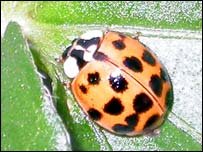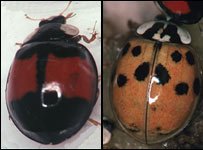☆•♥°ąყ℮Տիმ°♥•☆
In need of Dua
- Messages
- 1,007
- Reaction score
- 127
- Gender
- Female
- Religion
- Islam
Native ladybirds 'under threat'

A foreign species of ladybird is threatening to drive three native British varieties to extinction, conservationists say.
The harlequin species, which arrived two years ago from continental Europe, is larger than British varieties and threatens them by taking their food.
The seven spot and the two spot, which until recently were common, are under threat along with the rarer five spot.
Charity Buglife wants the government to do more to protect these UK varieties
The Peterborough-based charity, also known as the Invertebrate Conservation Trust, says the harlequin also damages crops by eating fruit.
Huge appetite
A survey was launched at the National History Museum back in March to track the spread of the voracious predator known to easily out-compete home bugs for food.
Wildlife enthusiasts were asked to monitor their gardens for the harlequin which is black and red or orange and black.
Buglife director Matt Shardlow said at the time: "The harlequin may sound like a bit of a jester but there is nothing funny about it at all.
"There're a whole lot of problems it will bring with it. It out-competes native species and eats them.
"Everyone should be vigilant for the species and record where it is."
The insect - originally from south-east Asia - has a huge appetite for greenfly, leaving little for native ladybirds who then starve.
Worse still, organisers of the survey said, the harlequin would turn on other ladybirds if food resources diminished for the whole population.
The invader will also prey on other types of insects, eating butterfly eggs, caterpillars and lacewing larvae.

HOW TO SPOT A HARLEQUIN

A foreign species of ladybird is threatening to drive three native British varieties to extinction, conservationists say.
The harlequin species, which arrived two years ago from continental Europe, is larger than British varieties and threatens them by taking their food.
The seven spot and the two spot, which until recently were common, are under threat along with the rarer five spot.
Charity Buglife wants the government to do more to protect these UK varieties
The Peterborough-based charity, also known as the Invertebrate Conservation Trust, says the harlequin also damages crops by eating fruit.
Huge appetite
A survey was launched at the National History Museum back in March to track the spread of the voracious predator known to easily out-compete home bugs for food.
Wildlife enthusiasts were asked to monitor their gardens for the harlequin which is black and red or orange and black.
Buglife director Matt Shardlow said at the time: "The harlequin may sound like a bit of a jester but there is nothing funny about it at all.
"There're a whole lot of problems it will bring with it. It out-competes native species and eats them.
"Everyone should be vigilant for the species and record where it is."
The insect - originally from south-east Asia - has a huge appetite for greenfly, leaving little for native ladybirds who then starve.
Worse still, organisers of the survey said, the harlequin would turn on other ladybirds if food resources diminished for the whole population.
The invader will also prey on other types of insects, eating butterfly eggs, caterpillars and lacewing larvae.

HOW TO SPOT A HARLEQUIN
- Tends to be rounder in shape than most UK native species
- About 5-8mm in size - similar to the common seven spot
- It has a white plate with a big black M-shaped marking on it, just behind the head
- Sighted bugs can be orange with between 15 and 20 spots
- Others may be black with two orange or red spots
- Some also seen to be black with four orange or red spots
